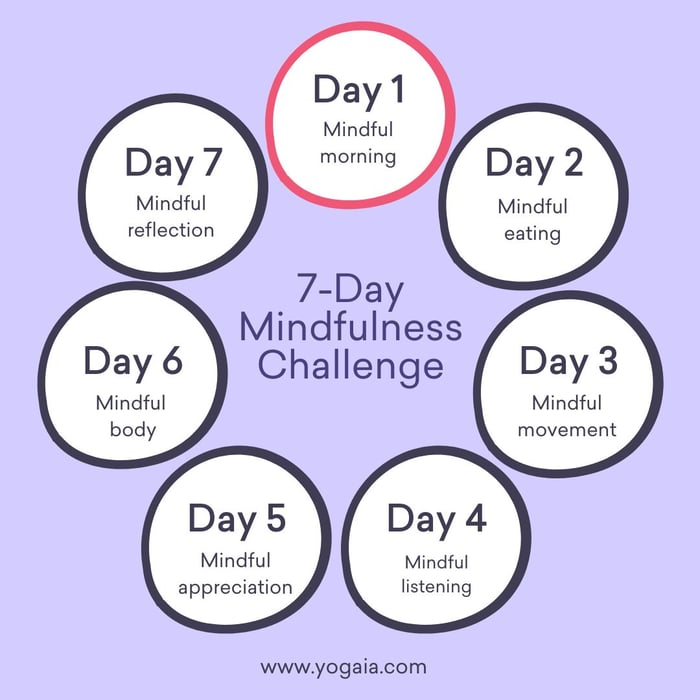
Waking Up to Your Life: Discovering the Power of Everyday Mindfulness
This is the March update of the Start Strong, Stay Strong program.
Table of Contents
Have you ever reached the bottom of your coffee cup without tasting a single sip? You're not alone.
The Everyday Mindfulness Starts with You
Picture this: You're standing in the shower, warm water cascading over you—but your mind is already at work, rehearsing conversations and building to-do lists. Your body is present, but your mind is elsewhere.
This month in Start Strong, Stay Strong, we're exploring how mindfulness can transform these ordinary moments into opportunities for presence and joy. Everyday mindfulness isn't about perfect meditation postures or emptying your mind—it's about showing up fully for your own life, one moment at a time.
Throughout this update, you'll discover practical tools to bring mindfulness into your daily routine:
- A tip on how to handle situations when mindfulness feels hard
- 5 tools to incorporate mindfulness into everyday
- A one-minute breathing exercise you can try right now
- A 7-day mindfulness challenge with simple daily practices
Feel free to try them all or choose the practices that resonate most with your lifestyle and current needs. Even incorporating just one of these exercises can begin to shift your relationship with the present moment.
Beyond the Meditation Cushion
Mindfulness teacher Jon Kabat-Zinn describes mindfulness as "paying attention in a particular way: on purpose, in the present moment, and non-judgmentally."
But what does this look like in real life?
- It's savoring the first bite of your breakfast instead of scrolling through emails
- It's feeling the sensation of your feet touching the ground as you walk
- It's truly listening to your colleague instead of mentally preparing your response
- It's noticing the weight and texture of the dish you're washing
These small moments of awareness add up to a life that feels richer, more connected, and more authentically yours.
When Mindfulness Feels Hard
Let's be honest—mindfulness isn't always blissful. Sometimes it's:
- Boring: "I've been focusing on my breath for 30 seconds and I'm already planning dinner"
- Uncomfortable: "When I slow down, I notice feelings I'd rather avoid"
- Frustrating: "My mind won't stop racing—I must be terrible at this"
- Seemingly pointless: "How is noticing my breath going to help my actual problems?"
These reactions aren't signs of failure—they're part of the practice. Instead of fighting them, try getting curious:
"Interesting—I'm feeling impatient right now. What does impatience feel like in my body?"
From Yogaia Member Lisa: A Mindfulness Breakthrough
"For weeks, I tried forcing myself to meditate for 20 minutes daily. I'd sit, get frustrated with my wandering mind, and give up. Everything changed when the teacher suggested I start with one mindful breath before checking my phone in the morning. Just one breath! That tiny practice grew naturally, and now mindfulness feels less like another task and more like coming home to myself."
Your Monthly Reflection
Before diving in, reset your mind with a short Yogaia class. Our 10-minute Refresh & Reset is perfect for creating mental space.
Once you're ready, consider:
- When in your daily routine do you find yourself rushing or going on autopilot?
- Recall a recent moment when you felt truly present. What elements made that possible?
- What specific distractions consistently pull you away from the present?
- How might your day feel different if you brought awareness to just one routine activity?
Notice your patterns without judgment—awareness itself is transformative.
The Mindfulness Toolkit
For morning fog: Try the "3-2-1" technique. Notice 3 things you see, 2 things you hear, and 1 physical sensation. This quickly anchors you in the present.
For work overwhelm: Practice "one task at a time" for just 10 minutes. Close extra tabs, put your phone away, and fully engage with a single task.
For emotional turbulence: Try "name it to tame it." Simply labeling emotions ("I'm feeling anxious") can reduce their intensity.
For physical tension: Conduct a 30-second body scan. Starting at your toes, notice sensations as you mentally move up your body.
For bedtime racing thoughts: Practice the "final three breaths" of the day. As you lie down, give three breaths your complete attention before sleep.
Try This Now: The Mindful Minute
Pause reading for just 60 seconds:
- Set a timer for one minute
- Close your eyes or soften your gaze
- Feel the weight of your body where it makes contact with your chair or floor
- Notice your natural breathing without changing it
- When your mind wanders (it will!), gently return to the sensation of breathing
How did that feel? Remember, there's no "perfect" experience—whatever happened was your authentic experience.
Your 7-Day Mindfulness Challenge
Monday: Mindful morning – Take three conscious breaths before reaching for your phone
Tuesday: Mindful eating – Enjoy the first three bites of one meal without distractions
Wednesday: Mindful movement – Feel the sensations in your body during a Yogaia class
Thursday: Mindful listening – Have one conversation where you focus entirely on listening
Friday: Mindful appreciation – Notice three beautiful things in your environment
Saturday: Mindful body – Take a shower or bath with full attention to sensations
Sunday: Mindful reflection – What did you discover this week?
Classes to Support Your Practice
- For beginners: Try our 5-minute "Calm in 5" with Craig
- For stress relief: Our 20-minute "Flow Away the Stress" with Shanine
- For better sleep: The 20-minute "Yoga Nidra" with Rishin
- For movement lovers: Our 25-minute "Vinyasa Flow" with Patricia
Setting Your Monthly Intention
Rather than aiming for perfect mindfulness, consider this intention: "I will bring kind awareness to one everyday activity each day."
Choose something you do regularly—brushing your teeth, waiting in line, walking to your car—and make it your mindfulness anchor.
This month, ask yourself: How might my life change if I showed up more fully for the small moments?

